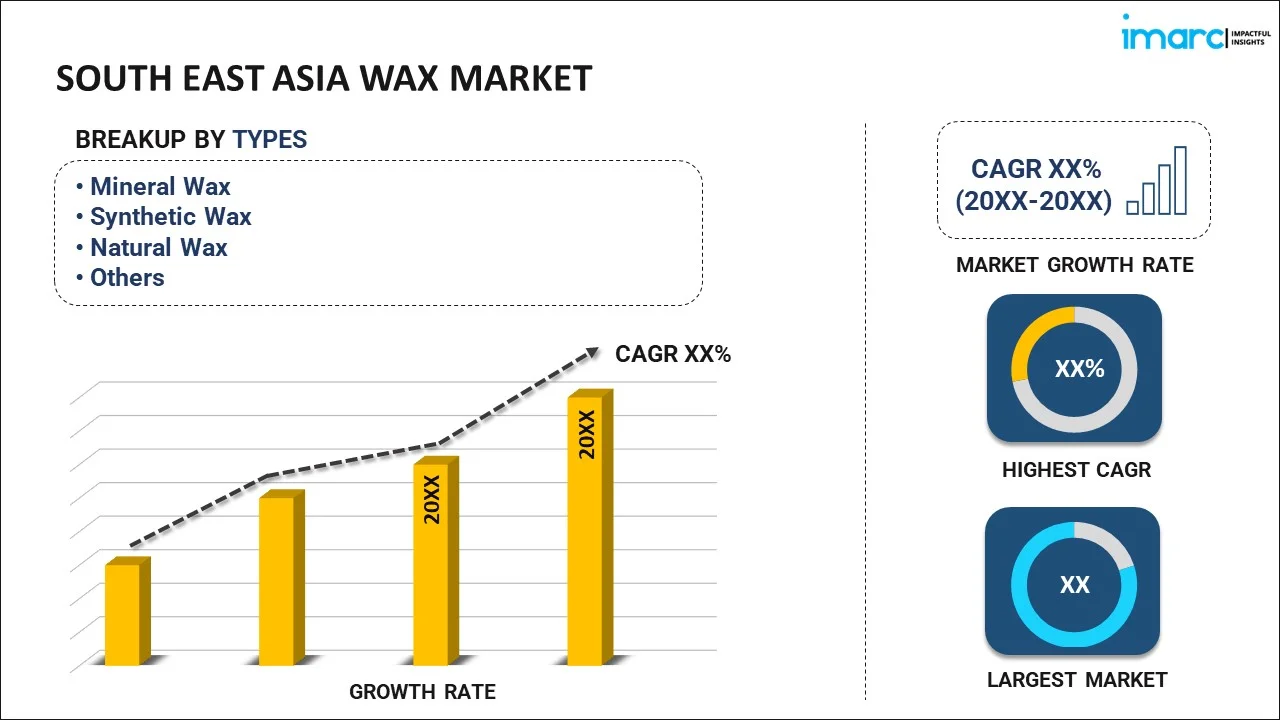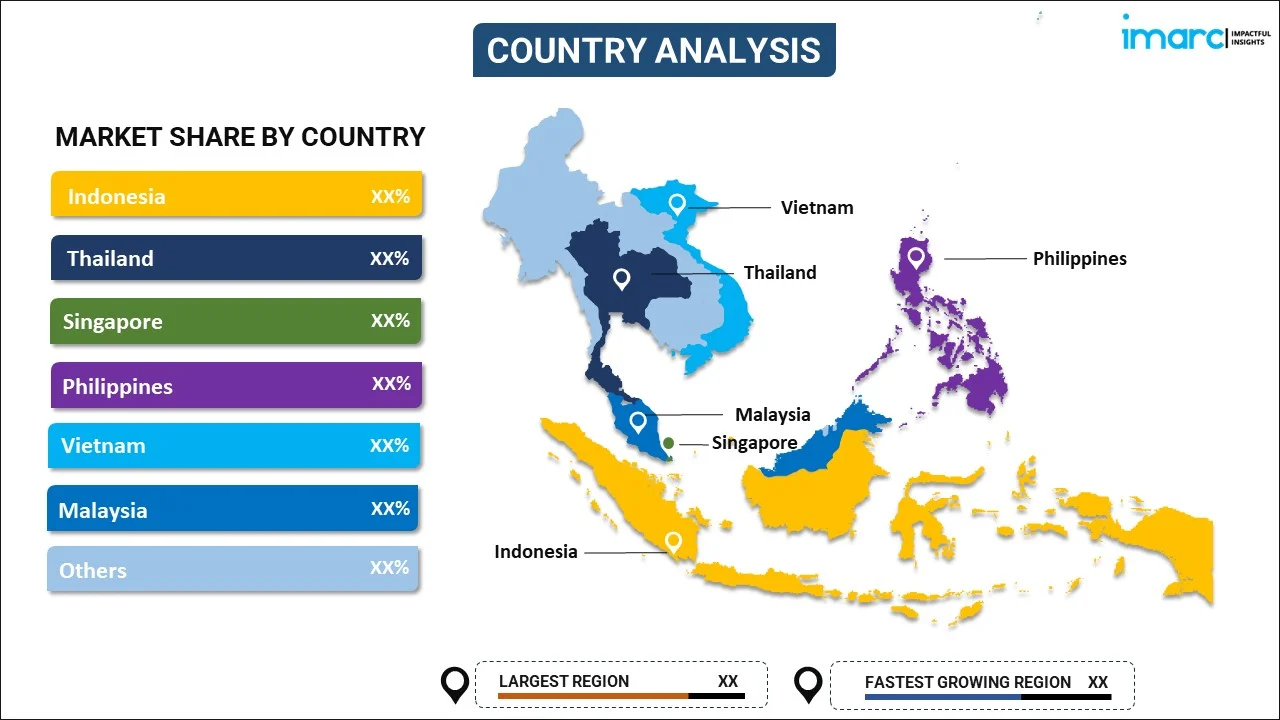
South East Asia Wax Market Report by Type (Mineral Wax, Synthetic Wax, Natural Wax, and Others), Form (Flakes, Granules, Powder, and Others), Application (Candles, Cosmetics, Packaging, Emulsions, Hot Melts, Floor Polishes, and Others), and Country 2025-2033
Market Overview:
South East Asia wax market size is projected to exhibit a growth rate (CAGR) of 2.76% during 2025-2033. The expanding packaging industry, including food packaging and luxury packaging, which relies heavily on waxes for coating and sealing purposes, is driving the market.
|
Report Attribute
|
Key Statistics
|
|---|---|
|
Base Year
|
2024 |
|
Forecast Years
|
2025-2033
|
|
Historical Years
|
2019-2024
|
| Market Growth Rate (2025-2033) | 2.76% |
Wax is a solid, plastic-like substance that is derived from various sources, including plants, animals, and petroleum. It is typically composed of a mixture of hydrocarbons and is characterized by its low melting point. Beeswax, one of the most common natural waxes, is produced by honeybees and is known for its various applications, ranging from candle making to cosmetics. Additionally, carnauba wax, obtained from the leaves of the carnauba palm, is widely utilized in the production of polishes, cosmetics, and confectionery products due to its high melting point and glossy finish. Petroleum waxes, on the other hand, are by-products of the oil refining process and find extensive use in the manufacturing of candles, packaging materials, and coatings. With its versatile properties and diverse applications, wax continues to be an integral component in numerous industries, contributing to the creation of a wide array of products and commodities.
South East Asia Wax Market Trends:
The wax market in South East Asia is experiencing robust growth, primarily driven by the burgeoning demand from various end-use industries. Firstly, the escalating popularity of natural waxes, such as beeswax and soy wax, is attributed to the increasing consumer preference for eco-friendly and sustainable products. Consequently, this has propelled manufacturers to expand their production capacities to meet the surging market demand. Moreover, the flourishing cosmetics and personal care industry has significantly contributed to the expansion of the wax market, as waxes are extensively utilized in the formulation of skin care products, lipsticks, and hair care items. Additionally, the burgeoning investments in the packaging industry, particularly in the food and beverage sector, have led to an augmented requirement for wax coatings owing to their superior barrier properties and preservation capabilities. Furthermore, the rising application of waxes in the pharmaceutical sector for encapsulation and coating purposes has further stimulated the growth of the wax market, with R&D activities aiming to enhance the efficacy and functionality of wax-based formulations. Consequently, these multifaceted drivers are expected to sustain the upward trajectory of the regional wax market in the foreseeable future.
South East Asia Wax Market Segmentation:
IMARC Group provides an analysis of the key trends in each segment of the market, along with forecasts at the regional and country level for 2025-2033. Our report has categorized the market based on type, form, and application.
Type Insights:

- Mineral Wax
- Synthetic Wax
- Natural Wax
- Others
The report has provided a detailed breakup and analysis of the market based on the type. This includes mineral wax, synthetic wax, natural wax, and others.
Form Insights:
- Flakes
- Granules
- Powder
- Others
A detailed breakup and analysis of the market based on the form have also been provided in the report. This includes flakes, granules, powder, and others.
Application Insights:
- Candles
- Cosmetics
- Packaging
- Emulsions
- Hot Melts
- Floor Polishes
- Others
A detailed breakup and analysis of the market based on the application have also been provided in the report. This includes candles, cosmetics, packaging, emulsions, hot melts, floor polishes, and others.
Country Insights:

- Indonesia
- Thailand
- Singapore
- Philippines
- Vietnam
- Malaysia
- Others
The report has also provided a comprehensive analysis of all the major regional markets, which include Indonesia, Thailand, Singapore, Philippines, Vietnam, Malaysia, and Others.
Competitive Landscape:
The market research report has also provided a comprehensive analysis of the competitive landscape in the market. Competitive analysis such as market structure, key player positioning, top winning strategies, competitive dashboard, and company evaluation quadrant has been covered in the report. Also, detailed profiles of all major companies have been provided.
South East Asia Wax Market Report Coverage:
| Report Features | Details |
|---|---|
| Base Year of the Analysis | 2024 |
| Historical Period | 2019-2024 |
| Forecast Period | 2025-2033 |
| Units | Billion USD |
| Scope of the Report | Exploration of Historical and Forecast Trends, Industry Catalysts and Challenges, Segment-Wise Historical and Predictive Market Assessment:
|
| Types Covered | Mineral Wax, Synthetic Wax, Natural Wax, Others |
| Forms Covered | Flakes, Granules, Powder, Others |
| Applications Covered | Candles, Cosmetics, Packaging, Emulsions, Hot Melts, Floor polishes, Others |
| Countries Covered | Indonesia, Thailand, Singapore, Philippines, Vietnam, Malaysia, Others |
| Customization Scope | 10% Free Customization |
| Post-Sale Analyst Support | 10-12 Weeks |
| Delivery Format | PDF and Excel through Email (We can also provide the editable version of the report in PPT/Word format on special request) |
Key Questions Answered in This Report:
- How has the South East Asia wax market performed so far and how will it perform in the coming years?
- What has been the impact of COVID-19 on the South East Asia wax market?
- What is the breakup of the South East Asia wax market on the basis of type?
- What is the breakup of the South East Asia wax market on the basis of form?
- What is the breakup of the South East Asia wax market on the basis of application?
- What are the various stages in the value chain of the South East Asia wax market?
- What are the key driving factors and challenges in the South East Asia wax?
- What is the structure of the South East Asia wax market and who are the key players?
- What is the degree of competition in the South East Asia wax market?
Key Benefits for Stakeholders:
- IMARC’s industry report offers a comprehensive quantitative analysis of various market segments, historical and current market trends, market forecasts, and dynamics of the South East Asia wax market from 2019-2033.
- The research report provides the latest information on the market drivers, challenges, and opportunities in the South East Asia wax market.
- Porter's five forces analysis assist stakeholders in assessing the impact of new entrants, competitive rivalry, supplier power, buyer power, and the threat of substitution. It helps stakeholders to analyse the level of competition within the South East Asia wax industry and its attractiveness.
- Competitive landscape allows stakeholders to understand their competitive environment and provides an insight into the current positions of Key Players in the market.
Need more help?
- Speak to our experienced analysts for insights on the current market scenarios.
- Include additional segments and countries to customize the report as per your requirement.
- Gain an unparalleled competitive advantage in your domain by understanding how to utilize the report and positively impacting your operations and revenue.
- For further assistance, please connect with our analysts.
 Inquire Before Buying
Inquire Before Buying
 Speak to an Analyst
Speak to an Analyst
 Request Brochure
Request Brochure
 Request Customization
Request Customization




.webp)




.webp)












